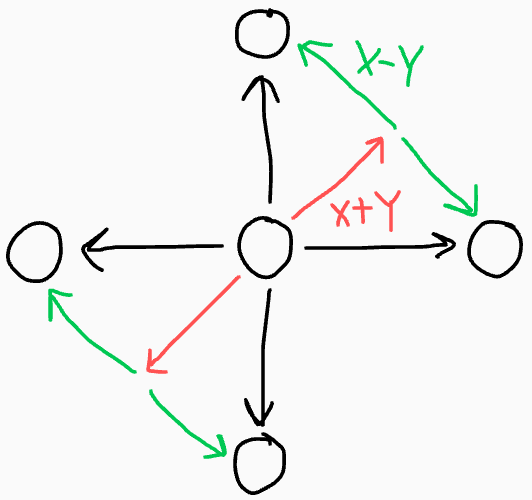I came across the fact that a random walk on an infinite 2d grid almost surely returns to the origin, and thought the proof was pretty cool.
Precise Statement: Suppose you start at . Every minute, you take one step
in the , , , or directions, each with probability .
You'll almost surely return back to at some point in the future.
First, let
be the infinite series where gives the probability of returning to the origin for the FIRST time on the th step of the walk. (The first few terms of are ).
Also, let
be a similar series, only that includes REPEATED visits to the origin as well. (Its first few terms are ).
Now and are related, in that any walk that visits the origin multiple
times can be decomposed into smaller segments for every time it visits the
origin. For example, the product represents a generating function
for the probability of being at the origin for the nd time. It sums terms
over all , representing the walks that first return to the origin
on step and then again on step .
Similarly, is a generating function for the probability of being
at the origin for the rd time, and in general, represents the
generating function for being at the origin for the th time. Thus, the
probability of being at the origin at any time satisfies
Rearranging, this gives
The ultimate goal is to show that the walk almost surely returns to the origin, or in more precise terms,
This is equivalent to evaluating , since for all . But from the above relation, we have , so it is enough to show that diverges.
Claim: diverges
The idea is that is much easier to compute than , since there is no longer a restriction on the prior steps of the walk.
Let
(since any return to the origin must be at an even time); then
is the number of walks returning to the origin, divided by
total possible walks. Surprisingly, it's possible to compute this
quantity exactly!
Instead of having four possible equally likely movements, look at each
movement as two independent choices on whether to increase/decrease ,
and whether to increase/decrease :

After movements, we've made red choices and green choices.
Since the origin has , exactly half of the red choices are up-right,
and the other half down-left. These can occur in any order, giving
possibilities. Similarly, since the origin has , there are
ways to arrange the green choices.
Therefore, the total number of walks that return to the origin after
steps is , so
By Stirling's approximation, , which gives
Since is now bounded by a harmonic series, it diverges, finishing the proof.
What is interesting to note is that in 3D, while the probability of is
not easy to determine, it's asymptotic to instead of . So
in 3D, the sum actually converges, meaning . Empirically, the
probability of returning to the origin in 3D is close to .